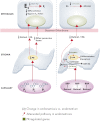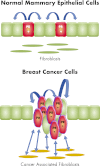Progesterone action in endometrial cancer, endometriosis, uterine fibroids, and breast cancer
- PMID: 23303565
- PMCID: PMC3565104
- DOI: 10.1210/er.2012-1043
Progesterone action in endometrial cancer, endometriosis, uterine fibroids, and breast cancer
Abstract
Progesterone receptor (PR) mediates the actions of the ovarian steroid progesterone, which together with estradiol regulates gonadotropin secretion, prepares the endometrium for implantation, maintains pregnancy, and differentiates breast tissue. Separation of estrogen and progesterone actions in hormone-responsive tissues remains a challenge. Pathologies of the uterus and breast, including endometrial cancer, endometriosis, uterine fibroids, and breast cancer, are highly associated with estrogen, considered to be the mitogenic factor. Emerging evidence supports distinct roles of progesterone and its influence on the pathogenesis of these diseases. Progesterone antagonizes estrogen-driven growth in the endometrium, and insufficient progesterone action strikingly increases the risk of endometrial cancer. In endometriosis, eutopic and ectopic tissues do not respond sufficiently to progesterone and are considered to be progesterone-resistant, which contributes to proliferation and survival. In uterine fibroids, progesterone promotes growth by increasing proliferation, cellular hypertrophy, and deposition of extracellular matrix. In normal mammary tissue and breast cancer, progesterone is pro-proliferative and carcinogenic. A key difference between these tissues that could explain the diverse effects of progesterone is the paracrine interactions of PR-expressing stroma and epithelium. Normal endometrium is a mucosa containing large quantities of distinct stromal cells with abundant PR, which influences epithelial cell proliferation and differentiation and protects against carcinogenic transformation. In contrast, the primary target cells of progesterone in the breast and fibroids are the mammary epithelial cells and the leiomyoma cells, which lack specifically organized stromal components with significant PR expression. This review provides a unifying perspective for the diverse effects of progesterone across human tissues and diseases.
Figures








Similar articles
-
Role of nuclear progesterone receptor isoforms in uterine pathophysiology.Hum Reprod Update. 2015 Mar-Apr;21(2):155-73. doi: 10.1093/humupd/dmu056. Epub 2014 Nov 18. Hum Reprod Update. 2015. PMID: 25406186 Free PMC article. Review.
-
Regulation of progesterone receptor expression in endometriosis, endometrial cancer, and breast cancer by estrogen, polymorphisms, transcription factors, epigenetic alterations, and ubiquitin-proteasome system.J Steroid Biochem Mol Biol. 2023 Mar;227:106199. doi: 10.1016/j.jsbmb.2022.106199. Epub 2022 Sep 30. J Steroid Biochem Mol Biol. 2023. PMID: 36191723 Review.
-
Adenomyosis pathogenesis: insights from next-generation sequencing.Hum Reprod Update. 2021 Oct 18;27(6):1086-1097. doi: 10.1093/humupd/dmab017. Hum Reprod Update. 2021. PMID: 34131719 Free PMC article. Review.
-
Interleukin-1β inhibits estrogen receptor-α, progesterone receptors A and B and biomarkers of human endometrial stromal cell differentiation: implications for endometriosis.Mol Hum Reprod. 2019 Oct 28;25(10):625-637. doi: 10.1093/molehr/gaz045. Mol Hum Reprod. 2019. PMID: 31408162 Free PMC article.
-
Ovarian steroids, stem cells and uterine leiomyoma: therapeutic implications.Hum Reprod Update. 2015 Jan-Feb;21(1):1-12. doi: 10.1093/humupd/dmu048. Epub 2014 Sep 8. Hum Reprod Update. 2015. PMID: 25205766 Free PMC article. Review.
Cited by
-
Mono-(2-ethyl-5-hydroxyhexyl) phthalate promotes uterine leiomyoma cell survival through tryptophan-kynurenine-AHR pathway activation.Proc Natl Acad Sci U S A. 2022 Nov 22;119(47):e2208886119. doi: 10.1073/pnas.2208886119. Epub 2022 Nov 14. Proc Natl Acad Sci U S A. 2022. PMID: 36375056 Free PMC article.
-
Current Knowledge on Endometriosis Etiology: A Systematic Review of Literature.Int J Womens Health. 2021 Jun 1;13:525-537. doi: 10.2147/IJWH.S306135. eCollection 2021. Int J Womens Health. 2021. PMID: 34104002 Free PMC article. Review.
-
ATM may be a protective factor in endometrial carcinogenesis with the progesterone pathway.Tumour Biol. 2015 Mar;36(3):1529-37. doi: 10.1007/s13277-014-2712-4. Epub 2015 Jan 22. Tumour Biol. 2015. PMID: 25608836
-
Activation of protein kinase B by WNT4 as a regulator of uterine leiomyoma stem cell function.Fertil Steril. 2020 Dec;114(6):1339-1349. doi: 10.1016/j.fertnstert.2020.06.045. Epub 2020 Sep 4. Fertil Steril. 2020. PMID: 32892998 Free PMC article.
-
Stromal Pbrm1 mediates chromatin remodeling necessary for embryo implantation in the mouse uterus.J Clin Invest. 2024 Mar 1;134(5):e174194. doi: 10.1172/JCI174194. J Clin Invest. 2024. PMID: 38426493 Free PMC article.
References
-
- Lydon JP, DeMayo FJ, Funk CR, Mani SK, Hughes AR, Montgomery CA, Jr, Shyamala G, Conneely OM, O'Malley BW. 1995. Mice lacking progesterone receptor exhibit pleiotropic reproductive abnormalities. Genes Dev 9:2266–2278 - PubMed
-
- Graham JD, Clarke CL. 1997. Physiological action of progesterone in target tissues. Endocr Rev 18:502–519 - PubMed
-
- Mulac-Jericevic B, Mullinax RA, DeMayo FJ, Lydon JP, Conneely OM. 2000. Subgroup of reproductive functions of progesterone mediated by progesterone receptor-B isoform. Science 289:1751–1754 - PubMed
Publication types
MeSH terms
Substances
Grants and funding
LinkOut - more resources
Full Text Sources
Other Literature Sources
Medical
Research Materials
Miscellaneous

